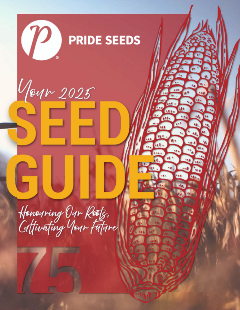Browse our selection of products below
___________________________________________________________________________________________________________________________________________

2024-2025 PRIDE Seeds Product GuideYou can find all of our products on the website, including supporting performance data and create your own personalized guide called My Guide. You can also download the digital version of our printed product guide which includes product comparison charts. |
Enhance your knowledge and stay ahead with PRIDE SEEDS Corn and Soybean School videos.
SHOP THE PRIDE SEEDS E-STORE
-7.png?sfvrsn=87920db3_3)
STAY UP-TO-DATE WITH PRIDE SEEDS LATEST BLOGS, NEWS AND ARTICLES
Analyzing Potential Yield Loss from Drought Stress
When you look at moisture loss to date, evaporation is the major issue because most of the plants are in the V5 to V7 stage and transpiration rates are low. Transpiration rates increase as the plants advance through the vegetative stages and leaf area increases. This results in higher evapotranspiration losses, which is a combination of both evaporation and transpiration.
Soil temperature comparisons between high residue situations like strip till into cover crops vs tilled soils have been as high as 70F (21C) difference with some tilled soils temperatures at 160F (71C). The areas that were first affected were areas of compaction, light soils and fields that have been in continuous corn. The combination of these factors has resulted in slow root growth that is limiting the plant ability to pull moisture from the soil.
Research has shown that root growth in corn-on-corn situations have half the root mass when compared to corn grown in crop rotations. Now, we are seeing plant stress in high clay soils and in corn following soybeans as well.
Leaf rolling is the major symptom of drought conditions. Leaf rolling occurs because monocot plants have bulliform cells that are three to five cells wide and span the length of the mid-vein of the corn leaf. It is proposed that they have a specialized cuticle layer that is more water permeable, and with the bulliform cells’ ability to shrink more than other leaf cells, it causes the leaf to roll. This reduces transpiration moisture loss and gives the plants more time for conditions to improve or more importantly receive rainfall. The plants have been recovering at night, which is a positive sign, but the earlier the plants begin to roll or the longer the period of rolling, the more stress the plant is under.
Yield loss is assumed when drought stress occurs for four or more consecutive days. The type of yield loss varies depending on the stages the corn plant is in. Early vegetative yield loss occurs from the potential loss of leaf area and making the plant speed through development, resulting in shorter plants. Ear diameter is being determined at the V6 to V8 stage, and ear length is determined from V8 to V17. Drought at these stages can impact the overall potential of the ear size. Corn that is pollinating can suffer from drought stress by reducing silk elongation, and drought can also impact the timing of silking and pollen shed. Temperatures above 100F (38C) can even kill the pollen grains. Plant stress during the grain fill period can result in kernel abortion or smaller light test weight kernels.
The greatest yield loss occurs when the corn plant is in the pollination stage, which can reduce yields by up to nine percent, and corn in the vegetative stage can see reduced yields of up to five percent.
| Corn Development Stage | Estimated Yield Loss per Day of Stress |
|---|---|
| Early Vegetative (VE – V12) | 1-3% |
| Late Vegetative (V12 – VT) | 2-5% |
| Pollination to Blister (R2) | 3-9% |
| Milk (R3) | 3-6% |
| Dough (R4) | 3-5% |
| Dent (R5) | 2-4% |
| Maturity (R6) | 0% |
Table 1: Percent corn yield loss estimates when drought stress occurs for four or more days. Table adapted from Iowa State University Extension and Outreach.
TAKE PRIDE IN YOUR INBOX
Expert advice, news and information
THE PRIDE SEEDS ADVANTAGE
Farming is one of the most demanding industries in the world, subject to a variety of factors such as time, weather, and global pressures. You know this every time you look out the window and think about the field in front of you. Growers and dealers deserve an advantage: The PRIDE Seed Advantage.
LEARN MORETHE PRIDE SEEDS ADVANTAGE
Every year PRIDE Seeds works hard to produce leading-edge products that enable success where it matters most, on your farm. Our dedicated team strives to provide sales expertise, agronomy support, quality production, and service tailored to meet your needs.
LEARN MORE

Leave a commentOrder by
Newest on top Oldest on top